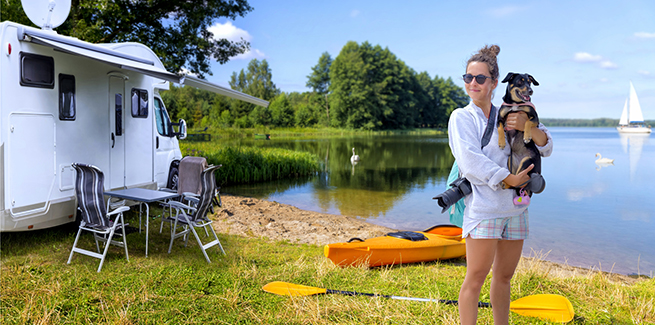Road tripping with dogs during a pandemic

You could probably use a vacation, but the US Centers for Disease Control (CDC) doesn’t agree—they suggest you stay home to stay safe. Despite the CDC’s recommendations, USA TODAY reports that 85% of Americans polled plan to take at least one road trip this summer, and, over the past month, there’s been a surge in campsite bookings and RV rentals.
What’s so different about this vacation season—besides the obvious? The RV rentals are a clue.
“Nobody wants to fly,” says Amy Stone, DVM, PhD. “Everybody’s getting in an RV or a car and going somewhere.” Often, they’re going to remote campgrounds, cabins, or beach houses where they can socially distance, get in some physical activity, and shake off their quarantine-induced cabin fever.
And because they’re not flying, they’re bringing their dogs.
Stone says people have gotten used to their dogs being around during lockdown, and they don’t want to leave them behind when they hit the road. But because of COVID, people are taking different kinds of vacations—vacations where social distancing is one of the objectives, with more athletic activities involved.
“So their dogs are being expected to do more things than they’ve done in the past,” she adds.
Stone, a clinical assistant professor of small-animal clinical sciences at the University of Florida’s College of Veterinary Medicine and chair of the 2020 AAHA/AAFP Feline Vaccination Guidelines (due to be published in JAAHA next month), says that’s a problem. Because a lot of those pet owners aren’t thinking about the ordeal they’ll be putting their pets through. “People are taking animals from places like way up north where it’s been cool and bringing them south to the heat, or taking them from places like Florida—where we live below sea level—to the mountains and saying, ‘Hey! Let’s go hike!’ And the animals are going, ‘Whoa, wait a minute!’”
Stone says acclimatizing dogs to a new geographic area is important. And pet owners are running into problems in places like Florida, such as their dogs developing heatstroke because they’re not used to the new environment.
“You can’t bring a dog to Florida from a place where there’s not as much humidity and expect them to run on the beach,” Stone says. It can take dogs as long as 90 days to acclimate to a shift in climate that extreme. “That’s three months before they’ll really be able to do things.”
Stone says Florida hospitals are seeing a huge spike in animals with heatstroke as well as an increase in injuries. “We’ve had pets show up with bite wounds because their owners were hiking, and the dog tangled with a raccoon.”
What veterinarians find out along the way reveals even more problems: “We go to booster the dog’s rabies [vaccine], and the owners say, ‘Oh, yeah, he’s not vaccinated for leptospirosis, either.’” Stone says dogs should probably be vaccinated for leptospirosis before leaving on vacation: “They may not be at risk where they live, but that could change depending on where they travel.”
She says veterinarians should talk to clients, and soon.
“Ask them if they’ll be traveling this summer, if they’ll be taking their dog, and where they’re going. Help them figure out if they’ll need additional or different vaccines. If they’re not on tick control, maybe they should be. If the animal isn’t typically on a flea preventive, you might want to think about getting them on that because they’re going to be outside more.”
As for Stone’s vacation, she and her husband are driving to a remote cabin where they can socially isolate and get in some hiking, “because that’s what we can do right now.”
And they’re leaving their greyhound at home with their daughter, both of whom are acclimated to Florida.
Photo credit: © Gettyimages/ewg3D



